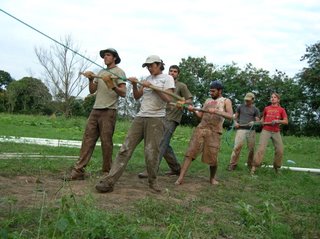So Wednesday morning we got up at 7am and after a quick breakfast we split up into two groups to drill the wells. Our team was headed up by a volunteer named Buck, who basically has spent the last two years living in a jungle-like community and tells stories of eel hunting in the swamp with some locals as well as a spider monkey he raised after some friends of his killed its mother on a hunting trip. Needless to say, this guy was a badass and we all learned a lot. When I say we were “drilling” a well, it’s probably more accurate to say we were pounding a well. We set up a pulley system using some logs and on one end of the rope was a primitive “bit” that we would use for drilling the hole. The rope went up through the pulley and on the other end was a team of us basically pulling as if we were rowing, constantly up and down, so the bit could pound into the ground. Some photos I think will clear up the confusion.
 Oiling the Pulley Before We Began Drilling
Oiling the Pulley Before We Began Drilling Did I Mention Drilling Was Dirty?
Did I Mention Drilling Was Dirty? The Rowing Team
The Rowing TeamWell drilling is a very messy and henceforth very fun job which I really really got into. My friends began joking that I actually preferred being dirty, which isn’t too far from the truth. By the end of the day, I was literally covered with a coating of very sticky mud...so much that I couldn’t feel the mosquitoes landing on me. I went to put on some bug spray and all it did was make the dried mud wet, I felt none on my skin. It was awesome. Well drilling is also pretty hard work and by the time it was all said and done, we had spent 19 hours pulling the rope and pounding the bit 25 meters into the ground till we hit a good aquifer. We were all a little bit loopy by the end, but it was quite fulfilling. I bet I would call it the single hardest day of work I’ve ever done…and I’ve put in some tough days hucking plaster for Joe Ranz. I’ll get into more details of well drilling in a later post.
After about the most satisfying showers of our lives, we snuck in a few hours of sleep. The next day was pretty laid back…we spent it learning how to make the primitive pumps and installing them into the wells. The main advantage to using this primitive technology is that it is very cheap…everything you need to drill a well can be found at the local hardware store and it’s pretty simple to teach the locals how to do it. This method was developed in Bolivia by a Baptist Missionary named Terry Waller, who now travels all around spreading his technology. I can’t remember the name of his organization right now, but I’ll tell you more about it later.
So on the third day, after finishing the wells, a group of us got up at 5:30 am to go to a fairly modern dairy (also in the compound) to milk some cows. It’s a local tradition to bring some Singani to mix with fresh cow milk and toast to your health. We got there and they let us milk the cows and there were even a few of us who drank milk straight from the udder! It was quite yummy I must say, and then when we mixed it with the Singani, it tasted like a warm White Russian. GW, you would have loved it. It’s been pretty fun learning the customs here and participating as much as we can. There is a lot of talk about integrating into the culture and I think learning about and doing things like this really helps.
 Breakfast of Champions
Breakfast of ChampionsWe then headed off to another nearby volunteer’s site to check out his dry latrine project. His site is called Okinawa and is actually a Japanese colony that sprouted up after World War II…there is a very large Japanese population there, and people are even still emigrating there from Japan today. It’s rich in history and culture and was a cool experience. Probably the best part of the visit though was eating at the sushi restaurant they had there. After busting our butts for about 8 days straight, it was really nice to sit down to a really good meal…even though the wasabe came out of tube.
 Sushi is Good
Sushi is GoodThat pretty much brought the work of Tech Week to an end, and we stayed that night in Santa Cruz city, eating more really really good food and relaxing a bit. Saturday we spent about 10 hours in the Peace Corps Land Cruisers heading back to Cochabamba, during which I finished my book, Travels With Charley by Steinbeck. It was quite fitting that on the last leg of my first trip in Bolivia that I finished a book about him traveling and learning about the people of the U.S. I highly recommend it to travelers young and old. Many thanks to the best damn Stater Buddy in the land for the gift.

No comments:
Post a Comment